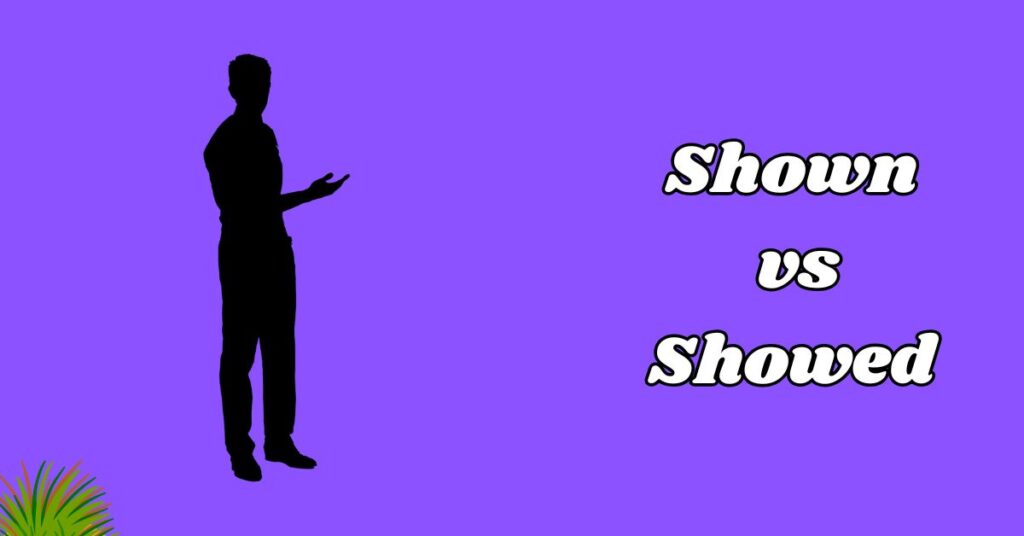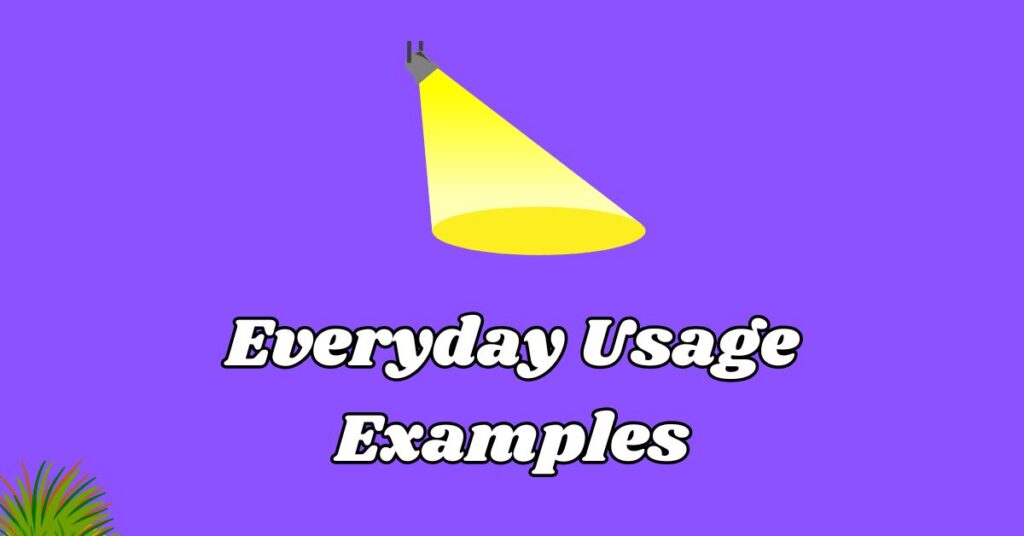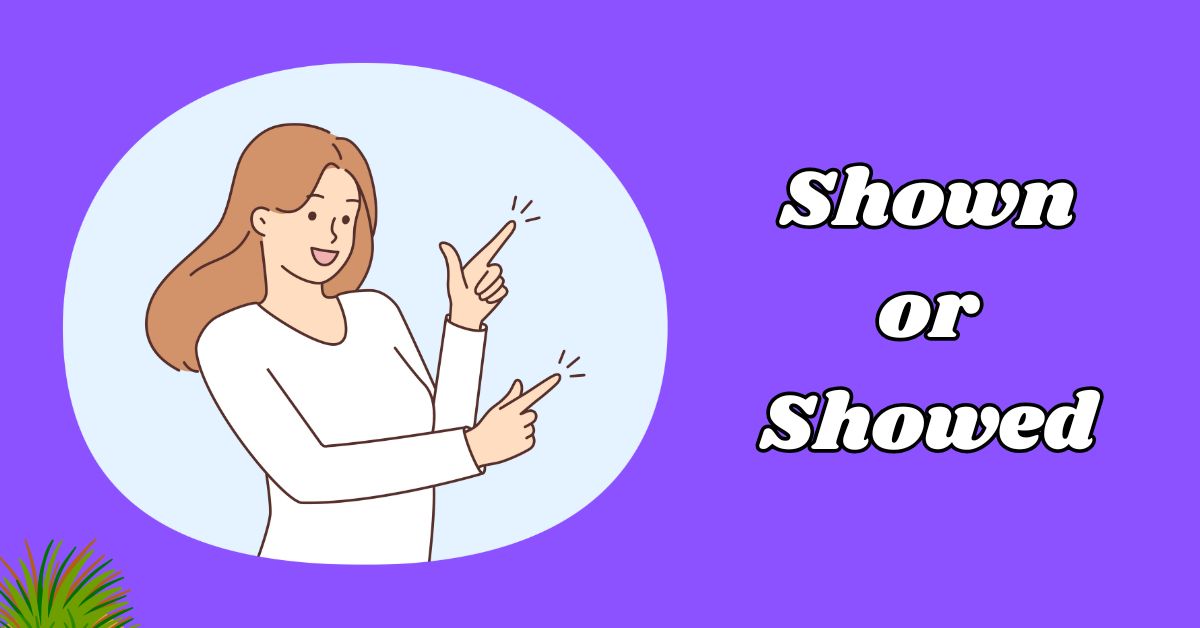Shown or Showed is a common point of confusion in English grammar, particularly when it comes to understanding the nuances of verb forms and tense rules. Mastering the difference between these two forms is crucial for effective communication, whether in writing or speech.
Shown is typically used as a past participle in perfect tenses or passive voice, while Showed serves as the simple past tense of the verb “show.” Understanding these distinctions helps avoid grammatical errors and ensures clarity in expression.
By grasping the proper usage of Shown vs Showed, you can enhance your English writing skills and improve your overall command of English grammar. This knowledge is essential for text generation and language translation tasks as well.
Quick Summary
The key difference between “shown” and “showed” lies in their grammatical roles. “Showed” is the simple past tense of “show,” while “shown” is the past participle form used with helping verbs like “have,” “has,” or “had.”
For example, you might say, “I showed her the photo yesterday,” but “I have shown her the photo several times.” Understanding this distinction will make your writing and speech more precise and professional.
Difference Between Shown vs Showed

When comparing shown vs showed, it’s important to note their function in grammar. “Showed” is used to describe a completed action in the past without requiring an auxiliary verb. For instance, “He showed me his new car.”
On the other hand, “shown” requires a helping verb to indicate perfect tense or passive voice. For example, “The results are accurate.” This difference highlights how verb tenses and structures influence meaning in English.
Origins of the Word Shown
The word “shown” originates from Middle English sheuen, derived from Old English sceawian, meaning “to look at, see, or observe.” Its Proto-Germanic root skau- and PIE root skou- emphasize the act of beholding or perceiving.
By 1200, English uniquely developed the causal sense of “let be seen” or “make known,” displacing earlier meanings. The spelling “shew”, popular in the 18th century, represented an archaic pronunciation. German schauen retains the original meaning of “to look at.”
Shown: Definition and Usage
Shown is the past participle form of the verb “show,” typically used with auxiliary verbs like “have,” “has,” or “had” to form perfect tenses. It is often used in passive voice constructions, such as “The results are accurate.”
This form emphasizes actions that have been completed or are ongoing, providing a sense of continuity. For example, “She has shown great potential in her work” highlights her consistent performance over time.
Shown Definition
Shown is the past participle of the verb “show,” used in perfect tenses or passive voice constructions. It describes something that has been displayed, revealed, or demonstrated. For example, “The evidence has been shown to the jury.”
In grammar, shown often requires a helping verb such as “have,” “has,” or “had” to form phrases like “has shown” or “had shown.” This form emphasizes completed actions or events.
Shown Pronunciation
The word shown is pronounced as /ʃoʊn/, rhyming with “known” and “grown.” It has a single syllable and is identical in pronunciation to “shone” in American English. This makes it easy to articulate and recognize in spoken language.
Uses of Shown in a Sentence
- The evidence has been shown to support the theory.
- She had shown great courage during the crisis.
- The movie has been shown in theaters worldwide.
- They have shown interest in buying the house.
- The data was shown to be accurate after testing.
Synonyms of Shown
| Synonym | Meaning |
| Displayed | Presented for viewing |
| Revealed | Made visible or known |
| Exhibited | Put on display |
| Demonstrated | Explained or proved |
| Presented | Offered for consideration |
| Highlighted | Emphasized or pointed out |
| Depicted | Represented visually |
| Illustrated | Explained with examples |
| Expressed | Conveyed an idea |
| Indicated | Pointed out or suggested |
Showed: Definition and Usage
Showed is the simple past tense of “show,” used to describe actions that occurred at a specific time in the past. It does not require an auxiliary verb and is often used in active voice, such as “He showed me his new car yesterday.”
This form emphasizes direct actions that are now been completed. For instance, “She showed her appreciation by sending flowers” illustrates a specific past action without ongoing implications.
Showed Definition
Showed is the simple past tense of the verb “show,” used to describe actions completed at a specific time in the past. For instance, “She showed me her new book yesterday.” Unlike shown, it does not require an auxiliary verb and is commonly used in active voice sentences. This form highlights direct actions that occurred in a defined timeframe.
Uses of Showed in a Sentence
- She showed her friends the new dress she bought.
- He showed me how to solve the math problem.
- The teacher showed us a diagram of the solar system.
- They showed their support by attending the rally.
- The artist showed his paintings at the gallery.
Side-by-Side Comparison
Here’s a table comparing shown vs showed:
| Feature | Shown | Showed |
| Verb Form | Past participle | Simple past |
| Requires Helping Verb | Yes | No |
| Example Sentence | I have shown my work. | I showed my work yesterday. |
| Usage Context | Perfect tense/passive voice | Completed action in past |
Everyday Usage Examples

In everyday language, shown and showed are used in distinct ways. For example, “The new policy has been shown to improve productivity” illustrates shown in a passive construction. On the other hand, “He showed his ID at the door” uses showed to describe a direct past action.
These examples highlight how shown often emphasizes ongoing or completed actions with the help of auxiliary verbs, while showed focuses on specific past events without them. Understanding these differences helps in crafting clear and effective sentences in both writing and speech.
Shown Example
The word shown is often used in sentences that emphasize ongoing or completed actions. For instance, “The data has been shown to support the theory” illustrates its use in a passive construction. This form is particularly useful when discussing results or evidence that have been revealed over time.
It requires a helping verb like “have” or “has” to indicate the perfect tense, making it clear that the action is either ongoing or has been completed.
Examples of Shown in Context:
- The report has been shown to contain errors.
- She had shown me her artwork before.
- The experiment was shown to be successful.
- They have shown interest in collaborating.
- His skills were shown during the competition.
Showed Example
Showed is commonly used to describe direct actions that occurred at a specific time in the past. For example, “She showed her friends the new dress” highlights a completed action without ongoing implications. This form is straightforward and does not require auxiliary verbs, making it ideal for narratives about past events.
It emphasizes the action itself rather than its duration or continuation, providing clarity in storytelling and everyday conversation.
Examples of Showed in Context:
- He showed us his vacation photos last night.
- The guide showed them around the museum.
- She showed her appreciation by sending flowers.
- They showed up late for the meeting.
- The coach showed him how to improve his technique.
Common Mistakes
One common mistake when using shown and showed is confusing their grammatical roles. For instance, saying “He shown me the way” instead of “He has shown me the way” is incorrect. Similarly, using showed in perfect tenses, like “I have showed him,” is also a mistake.
It should be “I have shown him.” Understanding these differences is crucial for avoiding errors and ensuring clear communication in both writing and speech.
Tips to Avoid Mistakes:
- Remember that shown always needs a helping verb (e.g., “have,” “has,” “had”).
- Use showed for simple past tense without auxiliary verbs.
- Double-check your sentence structure when using perfect tenses.
- Practice distinguishing between active and passive voice constructions.
- Learn common examples for both forms to reinforce proper usage.
Tips to Remember the Differences
- Think of “shown” as part of a team—it always works with a helping verb like “have.”
- Associate “showed” with direct actions that happened at a specific time in the past.
- Use mnemonic devices such as “Helping verbs help ‘shown’ shine.”
- Read sentences aloud to check if they sound natural and grammatically correct.
- Study verb patterns and practice writing sentences using both forms.
More Article: Forrest or Forest: What’s the Difference
FAQs
Is it Shown or Showed?
Use shown with auxiliary verbs for perfect tenses or passive voice, and showed for simple past tense actions.
Is Shown grammatically correct?
Yes, shown is grammatically correct when used with helping verbs like “have” or “has.”
What is the meaning of Showed?
Showed means to have displayed or demonstrated something at a specific time in the past.
Conclusion
Mastering the difference between “Shown or Showed” is crucial for effective communication in English. Shown is used with auxiliary verbs to form perfect tenses or passive voice, while Showed describes direct past actions. Understanding these distinctions helps avoid grammatical errors and enhances clarity in writing and speech.
By practicing the correct usage of “Shown or Showed,” you can refine your English skills and convey your ideas more precisely. This knowledge is invaluable for both native speakers and learners alike.
Related Post: Mine as Well or Might as Well: Which One Is Correct?

